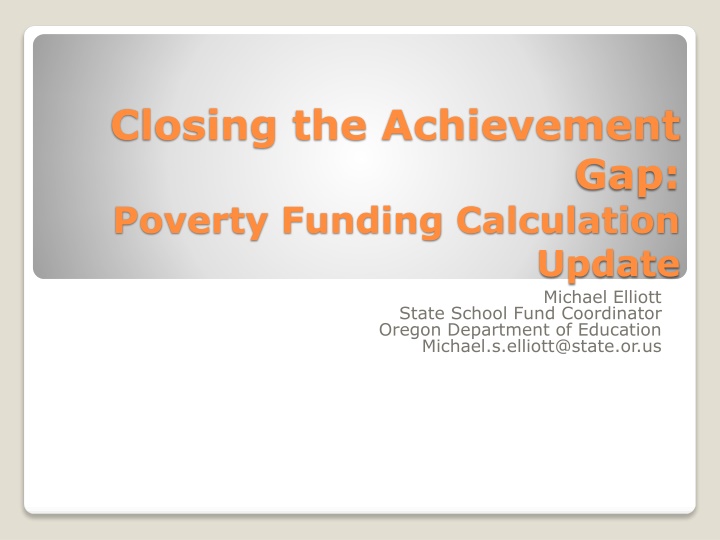
Update on Poverty Funding Calculation for Closing the Achievement Gap
Explore the latest updates and challenges in the poverty funding calculation process aimed at closing the achievement gap in education. Dive into data sets, rulemaking authority, legislative intent, concerns, and goals outlined in HB 2098. Learn about the nuances of Free and Reduced Lunch data and Small Area Income Poverty Estimates provided by the U.S. Census Bureau.
Download Presentation

Please find below an Image/Link to download the presentation.
The content on the website is provided AS IS for your information and personal use only. It may not be sold, licensed, or shared on other websites without obtaining consent from the author. If you encounter any issues during the download, it is possible that the publisher has removed the file from their server.
You are allowed to download the files provided on this website for personal or commercial use, subject to the condition that they are used lawfully. All files are the property of their respective owners.
The content on the website is provided AS IS for your information and personal use only. It may not be sold, licensed, or shared on other websites without obtaining consent from the author.
E N D
Presentation Transcript
Closing the Achievement Gap: Poverty Funding Calculation Update Michael Elliott State School Fund Coordinator Oregon Department of Education Michael.s.elliott@state.or.us
Overview of Poverty Calculation Previous Calculation HB 2098 Data Set Calculations Case Study Data Runs
Current Data Two Sets of Data: Large districts (greater than 2,500 ADMr) Census Data Change in ADMr
Current Data Small Districts (less than 2,500 ADMr) Greater of Census Data (see Large Districts) Portion of County s Free and Reduced Lunch count
Current Data Problems Accuracy Severity Changes
HB 2098 Rulemaking Authority Maintains 0.25 Weight
HB 2098: Legislative Intent Accurate Data Generally accessible and accepted data Use U.S. Census Bureau data
HB 2098: District Concerns No additional data collections
HB 2098: ODE Goals Transparency Accuracy
What about Free and Reduced Lunch Data? Different Definition Known underreporting Accuracy concerns
Small Area Income Poverty Estimate (SAIPE) U.S. Census Bureau data http://www.census.gov/did/www/saipe/ Updated annually District level data
SAIPE Statistical Model SNAP from U.S. Department of Agriculture IRS Data American Community Survey data
SAIPE Data provided: Population of district Population age 5-17 in district Population of age 5-17 in families in poverty
Poverty Calculation Start with SAIPE Data Total Population age 5 to 17 in school district
Poverty Calculation Problem: Not all children attend public schools Need accurate population in public schools
Poverty Calculation Solution: Use ADMr Percentage of children attending public school
Poverty Calculation 2 Steps: ???????? ???? ????? 5 ?? 17 ??????????= % ?????? ?? ??? ?????????? 1. 2. % ?????? ?? ??? ?????????? ????? ??????? ?????? = ??????? ????? ??? ??????? ???????
Poverty Calculation Problem: Some ADMr to SAIPE 5 to 17 ratios will be greater than 100% Charter School enrollment Inter-district transfers Open Enrollment
Poverty Calculation Solution: Cap ADMr to SAIPE 5 to 17 ration to 100% District gets SAIPE maximum Charter schools receive district percentage
Does this work? Salem Keizer: 1. SAIPE population age 5 to 17 = 45,269 2. ADMr = 37,999.07 3. SAIPE Poverty = 12,572
Does this work? Salem Keizer: ADMr SAIPE 37,999.07 45,269 = 83.94% ADMr-SAIPE ratio SAIPE Poverty 83.94% 12,572 = 10,553.01 Change in weights = 904.66 increase
Does this work? DHS and OHA published report on poverty hotspots Hotspot is a high concentration of family in poverty
Does this work? Data Used: Oregon SNAP data Oregon Employment Data DHS client data Available at: http://www.oregon.gov/dhs/ofra/ofradocu ments/High%20Poverty%20Hotspots%20 2013.pdf
Does this work? SAIPE v. Free and Reduced Lunch 140,000 300,000 130,000 290,000 120,000 280,000 110,000 270,000 100,000 260,000 SAIPE 90,000 250,000 FRLP 80,000 240,000 70,000 230,000 60,000 220,000 50,000 210,000 40,000 200,000 5 6 7 8 9 10 11
Data Sets Two data sets: 1. 2014-15 v 2014-15 Poverty Change 2. 2012-13 v 2013-14 ADMw
Data Sets First Data Set Compares change in poverty Change in weights Change in projected funding
Data Sets Second Data Set ADMw for 2012-13 compared to 2013-14 Shows extended ADMw interaction with poverty weights Extended ADMw calculation
Data Set #1: 3 Outcomes Outcome #1: Redmond SD 1. Poverty increased 2. Total funding increased
Data Set #1: 3 Outcomes Outcome #1: Redmond SD Poverty increased Increase of 273.53 to 443.49 Extended ADMw increased Increase of 273.53 to 8,166.64 Increase weights more than loss of $$/wt Increase of $1,940,717 $$/wt loss of $336,302
Data Set #1: 3 Outcomes Outcome #2: Bandon SD 1. Poverty decreased 2. Total funding decreased
Data Set #1: 3 Outcomes Outcome #2: Bandon SD Poverty decreased Decrease of 14.43 to 36.77 Extended ADMw remained the same Increase weights less than loss of $/wt Same weights $/wt loss of $38,602.69
Data Set #1: 3 Outcomes Outcome #3: Corvallis SD 1. Poverty increased 2. Total funding decreased
Data Set #1: 3 Outcomes Outcome #3: Corvallis SD Poverty increased Increase of 36.4 to 254.93 Extended ADMw increased Increase of 0.43 to 7,128.17 Increase weights less than loss of $/wt Increase of $3,049 $/wt loss of $293,965
Data Set #1: 3 Outcomes Outcome #3: Corvallis Breakdown extended ADMw: 1. Greater ADMw between 2013-14 and 2012-13 2. Charter school ADMw counted separate
Data Set #1: 3 Outcomes Outcome #3: Corvallis Extended ADMw School 2012-13 ADMw 7,021.40 97.03 2013-14 ADMw 6,861.20 106.35 Extended ADMw 7,021.40 106.35 7,127.74 Non-Charter Muddy Creek TOTAL Non-charter ADMw Difference: 160.20
Data Set #1: 3 Outcomes Outcome #3: Corvallis Extended ADMw 2013-14 ADMw has to increase by more than 160.2 to affect funding level
Summary 1. HB 2098: more accurate and up-to-date 2. SAIPE: district level with annual updates 3. Calculation: (ADMr/SAIPE Pop)* SAIPE Poverty 4. 3 outcomes 5. Next Steps
